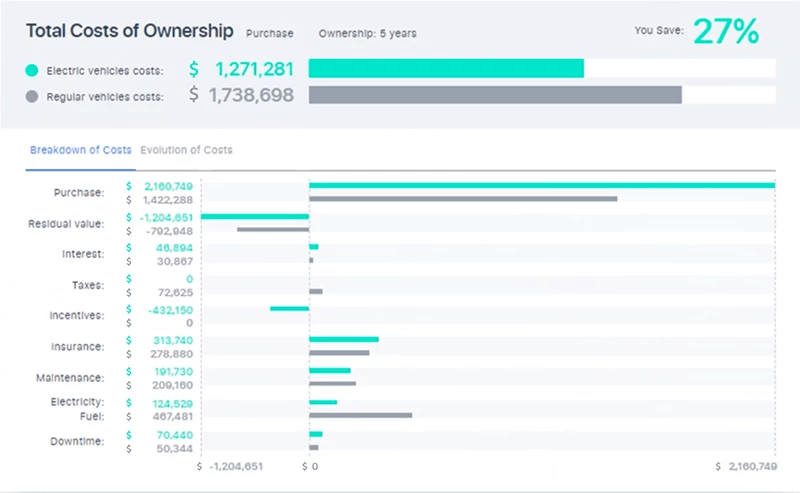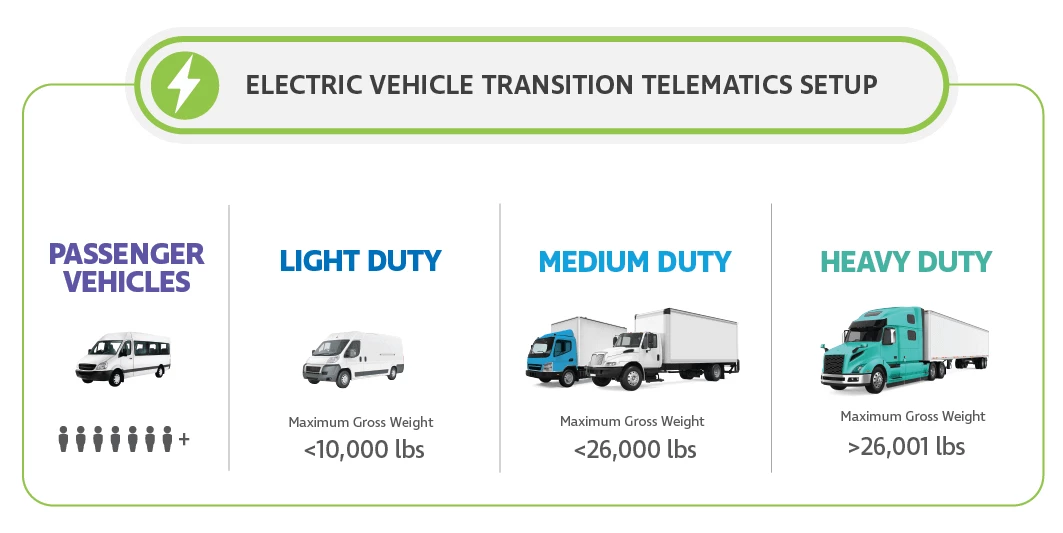Changing emissions standards have many fleet managers considering a switch to electric vehicle (EV) fleets. Here’s what you need to know about making the transition.
Transportation is responsible for approximately 20% of all carbon dioxide emissions because of burning fossil fuels. At the same time, vehicular travel is indisputably vital to many industries like transportation, construction, and the economy. Electric vehicles (EVs) can help reduce these CO₂ emissions, which has led many fleet managers to consider converting to an electric fleet.
Although this process may seem daunting at first, fleet management software can simplify the transition process in many different ways. By providing insight into your fleet operation it enables you to take a data driven approach to your transition so you can be confident that you your switch to alternative energy will have a positive impact on the environment, your team and business performance. Here’s what you need to know about taking a data driven approach to transitioning your fleet from internal combustion engines (ICE) to EVs.
Should I Switch to Electric Fleet Vehicles?
The issue of whether to convert to electric fleet vehicles is both a philosophical and a practical consideration. However, the answer heavily weighs in favor of making the transition when possible, in either case.
Environmental Considerations
Global EV sales continue to break records with strong consumer demand across all industries, including those with both light and heavy fleet vehicles. This can partly be attributed to global strategies designed to reduce or eliminate carbon emissions, like the United Kingdom’s Kingdom’s Road to Zero Strategy and the United States Inflation Reduction Act and it focus on clean energy.
The global carbon footprint of transportation is significant, but fleet vehicles can lead the way to a healthier planet. The reduction in greenhouse gas emissions per vehicle is significant over an asset’s life and when multiplied across an entire fleet, one company making the switch to greener vehicles can begin to make an impact.

Practical Considerations
Beyond the environmental considerations of converting to an electric vehicle fleet, there are financial considerations to make as well. Eco-friendly consumers are more aware of the environmental impact of businesses, and many are making purchase decisions accordingly. By transitioning to an EV fleet, businesses can improve their standing with these consumers to potentially increase revenue.
It’s also important to note the potential downsides to prolonging a transition to an electric vehicle fleet. With the previously mentioned emissions strategies set forth by various governments, the soft mandate for greener vehicles signals significant policy shifts in the coming years. By moving to an electric vehicle fleet now, companies can absorb costs gradually before regulations increase.
Potentially the strongest arguments for a transition to an electric vehicle fleet are the financial benefits. The cost savings over the lifetime of an electric vehicle when compared to an ICE vehicle are significant. In addition to moving away from a reliance on fossil fuels and their volatile prices, the maintenance costs of an electric vehicle over the life of the vehicle are also much lower. Finally, it’s worth noting that many government grants are currently available to ease transition costs. However, as adoption of electric vehicles increases over time, these subsidies may not always be available, highlighting the importance of considering a transition to electric vehicles sooner rather than later.
Making the Change to Electric Fleet Vehicles
Transitioning to an electric vehicle fleet requires careful planning and an intricate understanding of the impact to business operations, including costs and employee training. Additionally, ongoing support is required to ensure a successful transition. Here’s what you need to know about switching to an EV fleet.
Planning Phase
The planning phase of a transition to electric vehicles requires detailed knowledge of where your fleet stands today. An overnight transition to electric vehicles is unrealistic, which is why it’s necessary to understand how your current fleet is being used and in what order changes should be made to maximize cost effectiveness.
To ensure a successful transition to electric vehicles, businesses should take a data-driven approach. This is due to the significant investment required for both EVs and the charging infrastructure necessary to support them. To make informed decisions, businesses need access to data that factors in feasibility, cost, and business continuation.
The great news is that the information sits within telematics platforms and with the right vehicle type segmentation and an understanding of the key data points to focus on fleet operators can build a data driven transition plan.
Vehicle Type Segmentation
Your fleet should be segmented by vehicle type to evaluate how different vehicles are used within the business to assess their suitability for transition. This approach will help you identify which EV models could feasibly replace existing fleet vehicles. The recommended segmentation would be:
- Passenger Vehicles
- Light Duty (less than 10,000 lbs Max Gross Weight)
- Medium Duty (less than 26,000 lbs Max Gross Weight)
- Heavy Duty (more than 26,001 lbs Max Gross Weight)

Three Key Data Points
To plan an EV transition effectively, there are three key data points that businesses should focus on. This information can be accessed through reporting in a telematics platform and segmented by the vehicle types created. The three key data points are:
- Duty cycles: This information includes how much a vehicle is used and when it is used. For an EV, the number of days per week a vehicle is used and the average miles per measurement period are vital when calculating transition feasibility.
- Dwell time and location: This data indicates where vehicles are nonoperational, and the amount of time spent in these locations. This information is crucial for evaluating the charging requirements for an EV fleet and can help to plan an optimal charging infrastructure.
- Trip locations: Knowing the frequency with which vehicles enter low emission and congestion zones can help identify cost savings that can be included in total ownership cost calculations. This can bolster the case for an EV transition.
Execution Phase
Information is only useful when it’s put into action. For this reason, the execution phase requires buy-in from internal decision-makers. Here are some of the key factors and data points necessary to make informed decisions.
Total Cost of Ownership
All costs associated with owning and operating electric vehicles over their entire life cycle will need to be considered. This includes purchase price, maintenance costs, insurance, fuel and charging costs. Decision makers will want to compare the total cost of ownership of electric vehicles to their current gas or diesel vehicles to determine potential savings or additional costs.
Fuel Consumption Metrics
Fuel consumption metrics can help decision makers understand the practicality of using electric fleet vehicles in their specific use cases by identifying range per charge, energy consumption per mile and charging times. These can then be compared with similar data points from traditional internal combustion engine fleet vehicles.
Charging Infrastructure
Decision makers will need to consider whether they will need to install charging stations at their facilities, or if they will rely on public charging infrastructure. They will also want to understand the cost and time implications of charging their vehicles, and whether they will need to adjust their operations to accommodate charging times.
Government Incentives
Government incentives and rebates can significantly reduce the upfront cost of purchasing electric fleet vehicles, making them more financially feasible. Decision makers will want to understand what incentives are available in their region, and how much they can potentially save.
Environmental Impact
One of the main benefits of transitioning to electric fleet vehicles is the reduced environmental impact, including lower greenhouse gas emissions and other pollutants. Stakeholders will want to understand the potential environmental benefits of switching to electric vehicles. This includes any regulatory requirements they may need to comply with.
Vehicle Availability and Suitability
Fleet vehicles will need to be suitable for the needs of the company. This includes factors such as vehicle size, payload capacity, and driving range. Leadership teams will also need to consider factors such as road surfaces and driving distances to determine the best course of action for an electric vehicle fleet transition.
Employee Training
Transitioning to electric fleet vehicles will require employee training to ensure that drivers and maintenance personnel are familiar with the new technology, including operations and maintenance needs. Decision makers will need to consider the time and cost implications of training employees, as well as the ongoing training and support required to keep up with any changes in the technology.
Maintenance Phase
The key to long-term success with any project is ongoing support and flexibility. The future is always a moving target for operators, and your system needs to be able to adapt as your business grows and changes. Additionally, your systems and software need to be easy enough to use to ensure these changes can be made with relatively little downtime and loss of efficiency.
As more businesses begin the transition process to EVs, many fleets will include both ICE and EV vehicles. For this reason, your telematics software will also need to be able to handle both ICE vehicles and EVs from one platform to ensure efficient day-to-day operations.
As with any change, it’s critical that you and your business are confident in the decision being made, and that your team trusts the transition plan. Concerns on key issues like range anxiety and vehicle suitability can be addressed by following a data driven approach, that showcases that the business has the right charging infrastructure in place and they have correct vehicle for the job they’re doing.
Whatever stage your business is at with its energy transition, with our technology and team of experts you can start to make informed decisions that will ensure your business continues to thrive during and after the transition. Contact us today to learn more.

